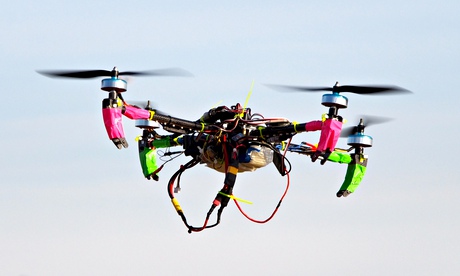
It is Glastonbury 2024, and you've got a front-row spot for the headline act, the Rolling Stones, concluding their fifth farewell tour. You need a drink badly, so you get out your smartphone and dial up a drone, which within minutes delivers a plastic bottle from the bar a mile away.
Science fiction? Not necessarily, after the online retailer Amazon revealed that it had written to the US Federal Aviation Authority (FAA) asking to test drones that could fly at up to 50mph and for 30 minutes at a time to deliver packages weighing up to 5lb (2.3kg).
In the letter (pdf), Amazon's head of public policy, Paul Misener, says that "in the past five months we have made advancements towards the development of highly automated aerial vehicles" for its new service, which it calls Amazon Prime Air. Misener says the five-pound limit covers 86% of products sold on Amazon.
Meanwhile, the FAA's British counterpart told the Guardian that it could foresee a time when, once drones have proven their airworthiness and ability to avoid obstacles safely, they would be allowed to operate autonomously. Under current legislation, Britain bans drones from being used within 50 metres of a building or person, and insists they must remain within line of sight – typically 500 metres – of the operator.
"The line of sight provision could go away some time in the future when we see a device able to make decisions about avoiding whatever objects are out there," said a Civil Aviation Authority spokesman. "They would also have to avoid other aerial obstacles, of course." Would-be operators would have to demonstrate the potential safety of their devices to the CAA to win permission.
Given a 25-mile range, Amazon's drones could serve an area of nearly 2,000 sq miles – far greater than the 609 sq miles inside the M25, which has a maximum radius of less than 20 miles.
Future improvements to drones could mean they would be available to all sorts of companies, according to one academic expert. Darren Ansell, aerospace engineering lead at the University of Central Lancashire, said: "A pizza company might not want to own and operate drones – so you could have operators offering a sort of transportation or postal-style service."
Amazon's chief executive, Jeff Bezos, floated the idea of drone-based delivery last December, though many critics were scornful of the idea, suggesting it was a publicity stunt as criticism swelled over the company's working practices and tax affairs.
But Misener's letter to the FAA says Amazon wants to bring the service into use "as soon as we are permitted to do so". It adds: "One day, seeing Amazon Prime Air will be as normal as seeing mail trucks on the road today."
With machine intelligence improving rapidly – as signalled by moves such as the £300m acquisition of the British artificial intelligence company DeepMind by Google this year – it is possible that Amazon, which has invested heavily in machine learning systems, could be among the first to crack the development of "safe" drones that can steer themselves. Alternatively, remote control as used by the military to pilot missile drones could be used.
Amazon says FAA regulations mean it has had to test its drones "indoors or in other countries" – though Amazon UK has not responded to questions about whether those countries have included the UK, or could in future. With the UK being a key market for Amazon, that seems very possible.
Ansell said the possible scenarios for drone use were growing all the time. "They could be almost like smartphones, where you just download a new app on to them and they can do something new." Key challenges were improving reliability – "they so far have the worst accident rate of any form of aviation" – and battery life, presently a maximum of 30 minutes.
The biggest hurdle, Ansell said, was the regulatory climate. Both the US and UK still strictly regulate commercial use of drones. In its plea to the FAA, Amazon says there are be multiple safety systems for the test drones, including automatic return if it loses contact with its controller, and a "kill switch" that the controller can use to force a landing.
Amazon will know that neither the FAA nor the CAA has so far been forgiving on those who have failed to control their drones. The CAA has successfully prosecuted two people in the UK for drone offences this year. One man lost control of his homemade one, which flew close to a road bridge over a river and landed near a nuclear facility. The other flew one over Alton Towers and was deemed to have been out of the line of sight.
In the US, New York police have expressed concerns that use of drones is running ahead of FAA permissions, after a privately owned one crashed in midtown Manhattan. Another drone alarmed pedestrians in Times Square as it hovered over them during the Super Bowl. A police officer reported a close call with another on the George Washington bridge.
The FAA fined the owner of the crashed drone $2,200 (£1,300) after he flew his four-engined quadcopter off a Manhattan building last year in a "careless and reckless manner". It ricocheted off two buildings and crashed near Grand Central rail terminal near a pedestrian.

